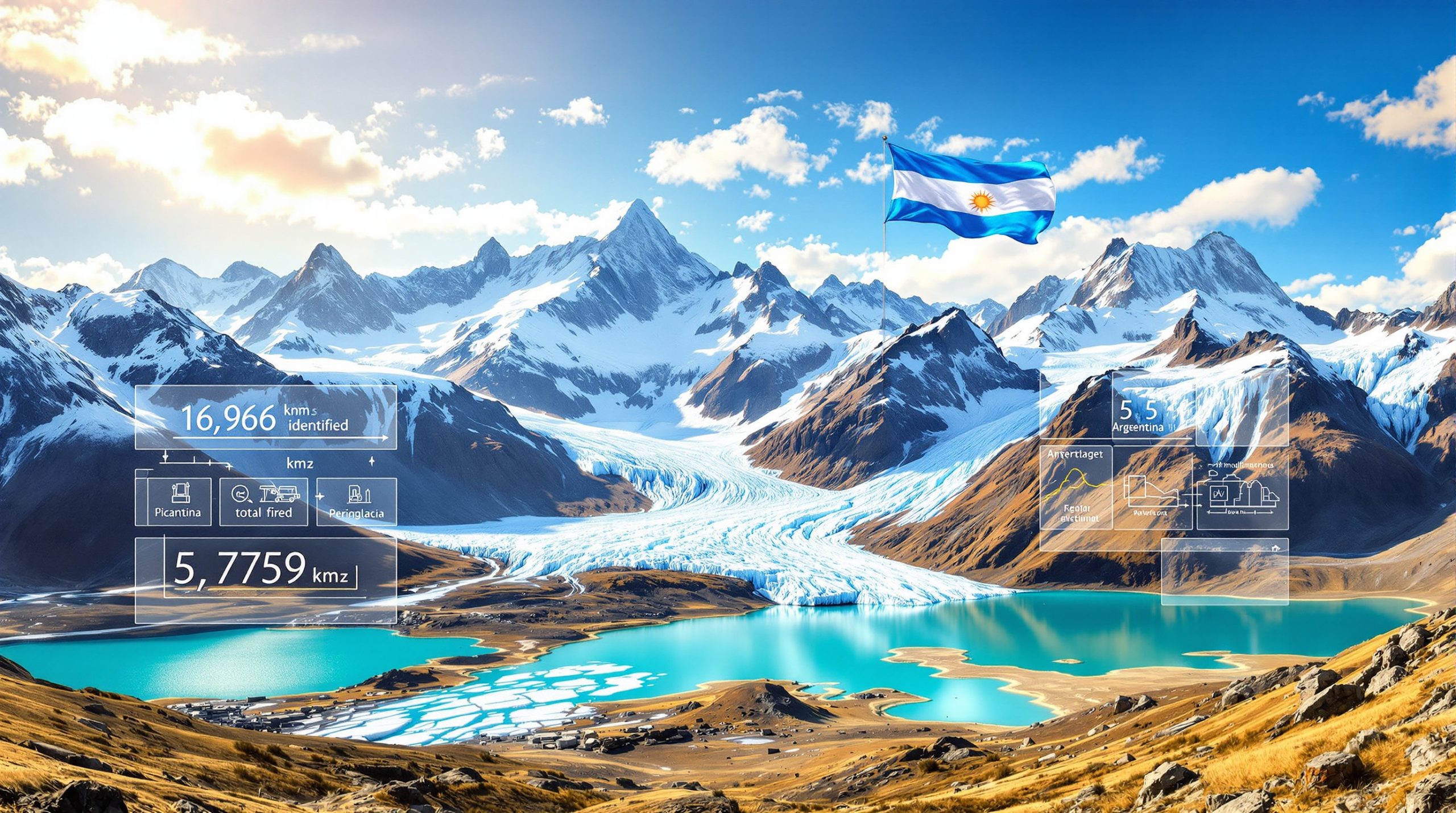Argentina's glacier protection framework represents one of the most comprehensive yet controversial environmental laws in Latin America. The Ley de glaciares en Argentina emerged from growing concerns about large-scale mining impacts on strategic water reserves, establishing unprecedented restrictions that continue to generate intense debate between environmental protection and economic development advocates.
Antecedentes Históricos: El Origen de la Protección Glaciar
Before 2010, Argentina completely lacked a specific regulatory framework for glacier protection. This normative absence became evident during a series of environmental conflicts related to mining projects in high mountain areas, particularly in Andean provinces where extractive activity began expanding towards higher altitude zones.
The decisive impulse to create this legislation arose from growing concern about the impact of large-scale mining on strategic water reserves. Initial parliamentary debates reflected deep tensions between provincial economic development and the need to preserve water resources for future generations.
During the legislative process, conflicting positions emerged between legislators from mining provinces like San Juan, Catamarca and La Rioja, who feared excessive restrictions on their regional economies, and representatives from other jurisdictions who prioritised environmental protection without economic conditions. Furthermore, the mining permitting process became a central point of contention throughout these discussions.
Marco Legal Fundamental: Estructura de la Ley 26.639
The Ley de glaciares en Argentina establishes precise legal definitions that distinguish between proper glaciers and periglacial environment. Glaciers are classified as masses of perennial ice, whilst the periglacial environment includes areas with permanently frozen soils and geoforms associated with freezing and thawing processes.
The regulation classifies these formations as public goods, removing them from traditional provincial domain over natural resources. This decision generated constitutional controversies that persist to this day, especially in provinces with important mineral deposits in highland areas.
The guiding principles of the law are based on the precautionary principle and the concept of sustainable development. The former establishes that faced with scientific uncertainty, the most environmentally protective alternative must be adopted, whilst the latter seeks to balance economic, social and environmental needs. Additionally, comprehensive mineral exploration insights have informed the development of these regulatory frameworks.
| Aspect | Description | Scope |
|---|---|---|
| Territorial scope | Glaciers and periglacial environment | Entire national territory |
| Prohibited activities | Mining, hydrocarbons, industries | Identified glacier zones |
| National inventory | Mandatory registry | IANIGLA as executing organism |
| Application authority | Shared Nation-Provinces | Interjurisdictional coordination |
¿Cuáles Son las Actividades Restringidas Bajo Esta Normativa?
Prohibiciones Absolutas en Zonas Glaciares
The law establishes categorical prohibitions for activities considered high environmental impact. Mining exploration and exploitation of any type is completely forbidden in areas identified as glaciers, without exceptions or possibilities for special authorisation.
Hydrocarbon activities face similar restrictions, encompassing from initial exploration to product transport. This prohibition includes the construction of oil pipelines, gas pipelines and all infrastructure related to the petroleum and gas industry.
Additionally, unauthorised infrastructure construction and release of polluting substances are prohibited, establishing a comprehensive protection regime that exceeds traditional extractive activities. However, recent industry developments show how some companies have halted uranium mining operations due to similar environmental concerns globally.
Regulaciones en Ambiente Periglacial
In periglacial zones, the regulation adopts a more flexible but equally rigorous approach. All economic activity requires mandatory environmental impact assessment, with specific studies demonstrating the absence of significant impact on the glacier system.
Specific glacier impact studies must be carried out by specialised professionals and validated by competent technical organisms. This requirement has generated significant delays in large-scale projects, increasing development costs and extending evaluation timeframes.
Prior authorisation for economic activities in periglacial environment requires coordination between national and provincial authorities, a process that frequently results in competency conflicts and administrative delays.
El Inventario Nacional de Glaciares: Herramienta Científica Clave
Metodología y Criterios Técnicos
The survey uses state-of-the-art satellite technology combined with field studies carried out by interdisciplinary teams. Satellite images allow identification of temporal variations in glacier extension, whilst terrestrial surveys provide data on thickness, composition and specific dynamics.
The classification contemplates different types of glacier formations: mountain glaciers, rock glaciers, névé and other periglacial geoforms. Each category requires specific evaluation methodologies and differentiated protection criteria.
Periodic updates based on scientific evidence guarantee that the inventory reflects climatic changes and natural dynamics. However, the frequency of updates has been criticised by productive sectors who consider the speed of incorporating new data insufficient.
Avances y Desafíos del Relevamiento
Until 2024, the inventory has managed to identify 16,968 glaciers distributed mainly in the Andean region. The total glacier surface reaches approximately 5,769 km², concentrated mostly in Patagonia, where climatic conditions favour ice formation and preservation.
Provinces with highest concentration include Santa Cruz, Mendoza and Neuquén, jurisdictions that also possess important mineral resources in highland zones. This geographical coincidence intensifies tensions between environmental protection and regional economic development.
National Inventory Statistics (2024)
- Total glaciers identified: 16,968
- Total glacier surface: Approximately 5,769 km²
- Provinces with highest concentration: Santa Cruz, Mendoza, Neuquén
- Registered periglacial environments: 1,615
The inventory has additionally identified 1,615 periglacial environments, zones that present intermediate characteristics between glaciers and conventional terrain. These areas are particularly conflictive from a regulatory standpoint, as their precise delimitation determines the viability of large-scale productive projects.
¿Cómo Afecta la Ley a la Industria Minera Argentina?
Impacto en Proyectos de Gran Escala
The application of the Ley de glaciares en Argentina has resulted in the paralisation of copper ventures valued at billions of dollars. Emblematic projects in San Juan, Catamarca and other Andean provinces have seen their operations suspended or face regulatory uncertainties that discourage investment.
Additional requirements for environmental studies have significantly increased pre-feasibility costs. Mining companies report increases of 200% to 400% in evaluation expenses, with deadline extensions that can reach several additional years.
The increase in evaluation and compliance costs is not limited to environmental studies, but includes specialised legal advice, additional insurance and financial contingencies to face possible paralysations or regulatory modifications. In fact, recent mining industry evolution trends show similar challenges across global markets.
Casos Emblemáticos de Aplicación
The suspension of geothermal projects in Neuquén (2010) marked the first practical application of the law. These developments, although oriented towards renewable energy, were affected by their location in periglacial zones, evidencing that restrictions transcend traditional mining.
Evaluations in mining projects in San Juan and Catamarca have generated significant legal precedents. Cases like Los Azules, Altar and Filo del Sol face review processes that extend for years, with financial costs that discourage investment continuity.
Jurisdictional conflicts between national and provincial authorities have intensified. Mining provinces claim exclusive competence over natural resources, whilst national organisms maintain the primacy of environmental protection as a constitutional minimum requirement.
La Posición de las Provincias: Federalismo vs. Protección Ambiental
Reclamos de Autonomía Provincial
The demands of San Juan, Catamarca and La Rioja are based on article 124 of the National Constitution, which establishes that provinces conserve original domain over natural resources existing in their territory. These jurisdictions argue that national law exceeds federal competencies.
Arguments about original competence are based on previous Supreme Court jurisprudence that recognised provincial authority over mineral resources. Provinces maintain that environmental protection cannot completely nullify their constitutional faculties for economic development.
Proposals for decentralised regulation seek to transfer application authority to provincial jurisdictions, maintaining national standards but allowing local adaptations according to specific geographical and economic characteristics. Furthermore, innovative approaches to mine reclamation innovations are being explored across different provinces.
Coordinación Interjurisdiccional
Consultation mechanisms between government levels include mixed technical commissions and joint evaluation protocols. However, these instruments have shown operational limitations, with frequent disagreements over technical criteria and regulatory scope.
Joint evaluation protocols require consensus between national and provincial authorities to approve projects in sensitive zones. This requirement has generated administrative delays that can extend for years, affecting the economic viability of private investments.
Resolution of competency conflicts traditionally falls to the Supreme Court of Justice, although the court has shown preference for negotiated solutions between parties rather than definitive rulings that could generate restrictive precedents.
¿Qué Dice la Corte Suprema Sobre la Constitucionalidad de la Ley?
Fallo de 2019: Confirmación de Validez Constitucional
The unanimous rejection of unconstitutionality claims presented by mining provinces strengthened the legal legitimacy of the regulation. The Supreme Court confirmed that glacier protection constitutes a valid environmental minimum requirement within the Argentine federal system.
The doctrine of "concertation federalism" established by the court requires effective coordination between Nation and provinces in environmental matters. This doctrine rejects both absolute centralisation and unrestricted provincial autonomy, promoting shared management schemes.
The balance between environmental protection and economic development was recognised by the Court as a legitimate constitutional challenge. The court established that the Constitution does not impose an absolute hierarchy between environmental and economic rights, but requires prudent harmonisation.
The Supreme Court established that environmental protection constitutes a constitutional right that must be harmonised with the federal regime, requiring coordination between Nation and provinces without nullifying provincial competencies over natural resources.
Implicaciones del Precedente Judicial
The legal shielding against future challenges is significant for regulatory stability. Mining companies can plan investments with greater certainty about the law's validity, although uncertainties persist about its practical application.
Criteria for resolving regulatory conflicts established by the Court prioritise intergovernmental coordination over unilateral solutions. This favours political negotiation schemes over imposed administrative or judicial decisions.
The framework for interpreting environmental minimum requirements transcends the Ley de glaciares en Argentina and applies to other environmental protection regulations. This doctrine influences debates about wetlands, native forests and other sensitive areas.
Debate Actual: ¿Modificación o Reglamentación?
Propuestas de Reforma del Gobierno Nacional
The option of regulatory decree vs. amendatory law reflects both technical and political considerations. An executive decree allows faster implementation but faces greater vulnerability to judicial challenges and government changes.
Transfer of competencies to provincial jurisdictions seeks to resolve federal tensions by granting greater local autonomy. This proposal has governors' support but generates resistance from environmental organisations that fear relaxation of protective standards.
More precise technical definitions include updated scientific criteria on glacier classification, periglacial limits and impact evaluation methodologies. These modifications could reduce regulatory uncertainties without modifying protection objectives.
Posiciones del Sector Empresarial
The demand for legal security for investments has intensified after years of regulatory uncertainty. International mining companies report difficulties obtaining project financing in Argentina due to perceived regulatory risks.
Clarification of ambiguous technical concepts includes precise definitions of "periglacial environment", "permafrost" and "protection zone". These precisions could reduce interpretative disputes without compromising environmental objectives.
More efficient authorisation procedures seek to reduce administrative timeframes through single windows, standardised protocols and predictable evaluation criteria. The private sector proposes maximum deadlines of 180 days for definitive resolutions.
| Sector | Principal Position | Specific Proposal |
|---|---|---|
| National Government | Controlled flexibilisation | Regulatory decree |
| Mining provinces | Jurisdictional autonomy | Provincial application authority |
| Mining sector | Technical precision | Clear scientific definitions |
| Environmental NGOs | Integral maintenance | Current strict application |
Impacto Económico: Inversiones en Juego
Proyectos Afectados por Incertidumbre Normativa
Copper ventures worth US$ 15 billion include emblematic projects like Filo del Sol, Los Azules and Altar. These investments could generate thousands of direct and indirect jobs, plus significant tax revenues for provinces with depressed regional economies.
Lithium developments in periglacial environment face additional restrictions in highland salt flats. Argentina possesses some of the world's largest lithium reserves, a critical mineral for global energy transition and electric vehicle development.
Energy infrastructure in mountain zones includes electrical transmission projects, geothermal energy and small hydroelectric plants. These works, although oriented towards renewable energy, may be affected by glacier restrictions.
Consecuencias en Competitividad Regional
Comparison with regulatory frameworks in Chile and Peru evidences Argentine competitive disadvantages. These countries have developed more flexible glacier protection systems, attracting investments that could have been directed to Argentina.
Loss of foreign investment opportunities intensifies in contexts of high global demand for critical minerals. Multinational companies report preferences for jurisdictions with more predictable and efficient regulatory frameworks.
The impact on trade balance and foreign exchange generation is significant in a context of external restrictions. Mining exports could contribute substantially to Argentine balance of payments, alleviating exchange and fiscal pressures.
¿Cuál Es el Futuro de la Ley de Glaciares?
Escenarios Posibles para 2025-2026
Legislative modification with federal consensus appears as the most probable scenario according to official sources consulted. This path requires complex negotiations between Nation, provinces and civil society sectors, but offers greater long-term legal stability.
Unilateral executive regulation constitutes a faster but politically risky alternative. A presidential decree could be implemented in months, although it would face probable judicial challenges and resistance from environmental organisations.
Maintaining the status quo with administrative improvements would involve conserving the current legal structure but optimising application processes. This option satisfies environmental demands but does not resolve business uncertainties about future investments.
Factores Determinantes del Cambio
International pressure for critical minerals intensifies with the global energy transition. The United States and other developed countries seek to diversify lithium, copper and rare earth suppliers, offering incentives to producer countries with stable regulatory frameworks.
Fiscal financing needs of the Argentine government could tip the balance towards greater flexibility. Mining royalty income and associated taxes are attractive in contexts of budgetary restrictions.
The balance between development and sustainability reflects broader tensions about economic growth models. Argentina's capacity to develop social consensus on these issues will decisively influence the law's future.
Perspectiva Internacional: Modelos Comparados
Experiencias Regulatorias Similares
Glacier legislation in Chile adopts a sectoral approach that differentiates protection levels according to specific characteristics of each zone. This model allows greater operational flexibility whilst maintaining rigorous environmental standards in critical areas. For more information on glacier protection laws, visit the Argentine government's environmental water department.
Canadian regulations are based on provincial management with minimal federal coordination. Canadian provinces maintain primary competence over natural resources, whilst the federal government establishes general environmental standards.
European frameworks prioritise integral protection through supranational instruments and community financing to compensate local development restrictions. This model is difficult to replicate in federal contexts like Argentina's.
Lecciones Aprendidas Globales
The importance of precise technical definitions emerges as a critical factor in all international experiences analysed. Clear and updated scientific criteria reduce litigation and facilitate business investment decisions.
Coordination between government levels requires specific institutionality and standardised procedures. Successful countries have developed specialised agencies and protocols that facilitate shared decision-making.
Participation of scientific communities in public policy definition improves the technical quality of decisions. The systematic incorporation of updated scientific knowledge strengthens the social legitimacy of environmental regulations. For additional perspectives on glacier protection advocacy, organisations like Greenpeace Argentina provide comprehensive coverage of key moments in this collective struggle.
Equilibrio Entre Protección y Desarrollo
The Ley de glaciares en Argentina represents a complex public policy challenge that transcends technical considerations to encompass constitutional, federal and economic dimensions. The search for balance between preservation of strategic water resources and exploitation of economic opportunities requires innovative solutions that satisfy multiple legitimate interests.
Its future evolution will depend fundamentally on the capacity of involved actors to build lasting technical and political consensus. International experience demonstrates that successful regulatory frameworks combine rigorous environmental protection with efficient and predictable decision-making procedures.
The context of global energy transition and growing demand for critical minerals grants particular urgency to these definitions. Argentina must decide whether to take advantage of its natural geological advantages or maintain restrictions that could limit its insertion into strategic value chains for the 21st century world economy.
Key Points to Remember:
- The law establishes integral protection of glaciers as strategic water reserves
- Its application generates tensions between national and provincial authorities
- The Supreme Court confirmed its constitutionality in 2019
- Current debate focuses on technical precision and competency distribution
- Future decisions will significantly impact national mining development
The effective implementation of any modification will require close coordination between multiple government levels, significant participation of scientific and technical communities, and construction of social consensus that transcends specific political conjunctures. Only through this integral approach will it be possible to guarantee both environmental protection and the viability of responsible productive investments that contribute to the country's sustainable development.
Looking to Navigate Argentina's Complex Mining Regulatory Landscape?
Discovery Alert's proprietary Discovery IQ model delivers real-time alerts on significant ASX mineral discoveries, instantly empowering subscribers to identify actionable opportunities whilst regulatory uncertainties in international markets create delays. Begin your 30-day free trial today and secure your market-leading advantage in discovering emerging mineral prospects.




